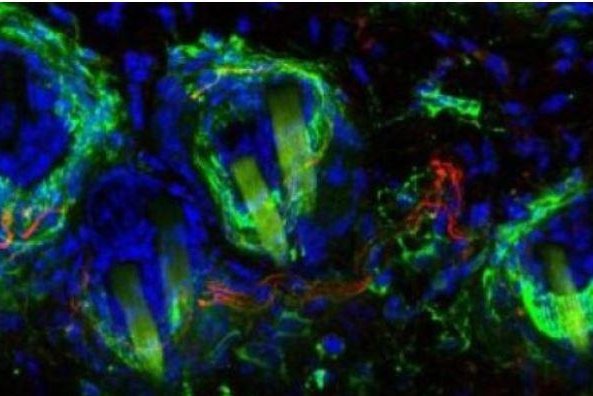The hairy skin of a mouse has nerve cells that are responsible for sensitivity to gentle touch, which appear in green. The neurons are located around hair follicles, which are in light green. Image courtesy of
Nature Communicatons
April 24 (UPI) -- Scientists at the European Molecular Biology Laboratory have developed a light-sensitive chemical that provides chronic neuropathic pain relief, based on a study of mice.
Researchers from EMBL Rome have identified nerve cells in the skin that are responsible for sensitivity to gentle touch and cause severe pain in neuropathic pain patients. Their findings were published Tuesday in Nature Communications.
An estimated 20 million people in the United States have some form of peripheral neuropathy, according to the National Institute of Neurological Disorders and Stroke.
"In neuropathic pain patients, hypersensitivity to light touch can develop to the extent that movement of a single hair shaft is sufficient to provoke severe pain," researchers wrote in the study. "This is difficult to treat using conventional analgesics such as opioid or NSAIDS [nonsteroidal anti-inflammatory drugs], and it impacts greatly upon quality of life due to the pervasive nature of mechanical stimuli; for example, small movements of the body, or the weight of clothing can cause severe pain in neuropathic patients."
The researchers noted there has been progress "in delineating the spinal circuits that gate mechanical pain," but the identity of the sensory neurons that input this sensation into the spinal cord is less clear.
These cells, which react to a breeze, tickling or an insect crawling across skin, are the only ones affected by light. Ones that allow for sensation of vibration, cold, heat or normal pain are not affected.
The researchers first injected the affected skin area with the light-sensitive chemical and, by illuminating it with near-infrared light, those nerve cells retracted from the skin's surface. After the treatment, a gentle touch is then no longer painful, researchers say.
"It's like eating a strong curry, which burns the nerve endings in your mouth and desensitizes them for some time," EMBL group leader Paul Heppenstall, said in a press release. "The nice thing about our technique is that we can specifically target the small subgroup of neurons causing neuropathic pain."
Past attempts to develop drugs for neuropathic pain have mostly focused on single molecules.
"We think, however, that there's not one single molecule responsible, there are many," Heppenstall said. "You might be able to succeed in blocking one or a couple, but others would take over the same function eventually. With our new illumination method, we avoid this problem altogether."
In mice, touch and pain were determined by measuring reflexes in them affected by neuropathic pain. With the pain, mice would quickly withdraw their paw. But after the light therapy, however, their reflexes were normal.
The normal reflexes to pain lasted for a few weeks after the light treatment, the researchers said, and then nerve endings grow back and gentle touch is again painful.
The researchers also found the overall makeup of the skin tissue and the specifics of the neurons appear to be similar in humans and mice.
"In the end, our aim is to solve the problem of pain in both humans and animals," Heppenstall said. "Of course, a lot of work needs to be done before we can do a similar study in people with neuropathic pain. That's why we're now actively looking for partners and are open for new collaborations to develop this method further, with the hope of one day using it in the clinic."















